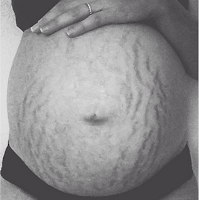by: Elizabeth Krieger
Many things change after you have a baby -- schedules, sleep time, and sense of freedom, to name a few.
Along with a changing schedule, there are the many physical changes you’ll see. Chief among them is stretch marks. For many women, stretch marks are as much a part of having a baby as diapers and feedings.
Anatomy of a Stretch Mark
Stretch marks happen when your body grows faster than your skin can keep up with. This causes the elastic fibers just under the surface of the skin to break, resulting in stretch marks.
You gain about 30 pounds during the 9 months you are pregnant, says Heidi Waldorf, MD, an associate clinical professor of dermatology at Mt. Sinai School of Medicine in New York City.Growing that fast can leave you with stretch marks, especially on your belly and breasts, two areas that grow the most. Stretch marks can also show up on the thighs, buttocks, and upper arms. The marks often start out reddish or purple, but after pregnancy they gradually fade to white or gray.
Experts say that women who are at a healthy weight should gain 25-35 pounds. “It’s not a bad idea to not only try to stay within that range but to also gain slowly and steadily, as opposed to in fast spurts,” says Mary Lupo, MD, a clinical professor of dermatology at Tulane University School of Medicine.
In other words, when it comes to stretch marks, how quickly you gain may be as important as how much you gain.
Who Gets Stretch Marks
If you have them, you’re in good company. About 90% of women will get them sometime after their sixth or seventh month of pregnancy, according to the American Academy of Dermatology.
If your mother had stretch marks, then you're more likely to have them too, since genetics plays a role.
If you have a lighter complexion, you will tend to develop pinkish stretch marks. Darker-skinned women tend to get stretch marks that are lighter than their skin tone.
Is Prevention Possible?
Unfortunately, there’s no way to prevent stretch marks. There’s not a cream, lotion or “mommy” balm that can do that -- and if that’s the claim on the bottle, don’t be fooled, Lupo says.
Keeping your skin hydrated with a rich lotion or cream is always a good idea, Lupo says, especially if it makes your skin feel better, look smoother and more toned, and helps the itchiness that can come with your growing belly.
Keeping your body hydrated with water helps too, says Anne Chapas, MD, a clinical instructor of dermatology at Mt. Sinai Medical Center.
Focus on Fading
While some stretch marks naturally fade to faint, silvery lines, others remain darker and more showy. The best time to treat the marks, Waldorf says, is while they're still in that reddish stage. Gels made with a mix of onion extract and hyaluronic acid may help. In one study, people using the gel said their marks faded after 12 weeks of daily use.
Another option is a retinoid, which your dermatologist can prescribe. “This speeds up cell turnover and can stimulate new collagen growth, leading to plumper, healthier skin,” Waldorf says. (You can’t use a retinoid if you’re pregnant or breastfeeding, though.)
Other in-office treatments include lasers that heat the skin. That boosts collagen growth and shrinks dilated blood vessels. It may take a number of sessions to see results, says Jeanine B. Downie, MD, a dermatologist in Montclair, NJ.Gentler processes such as dermabrasion can also help renew the skin, Downie says, but don't expect a big change.
Some women are simply trying to accept the new skin they’re in, now that baby has arrived. “Knowing that there’s really no magic spell, I have decided to embrace [the stretch marks] as a part of my new mom body. New curves, new shape -- new skin too,” Shaw says.

No comments:
Post a Comment